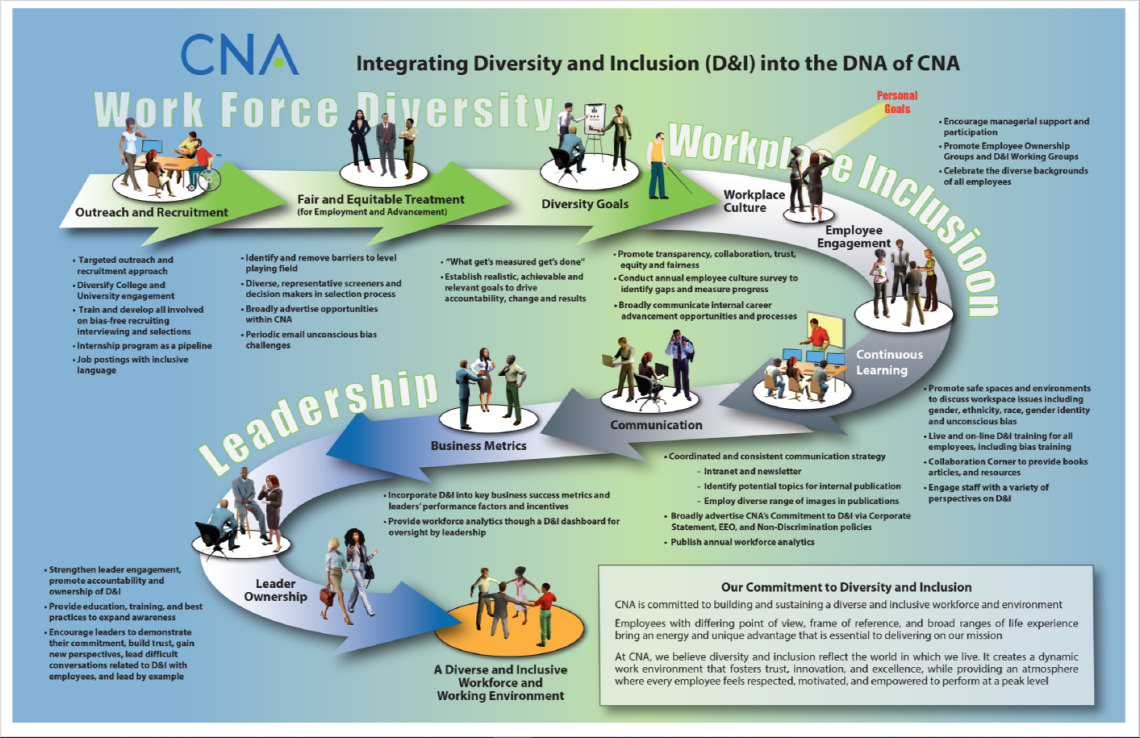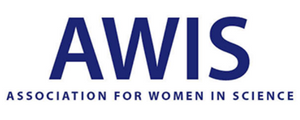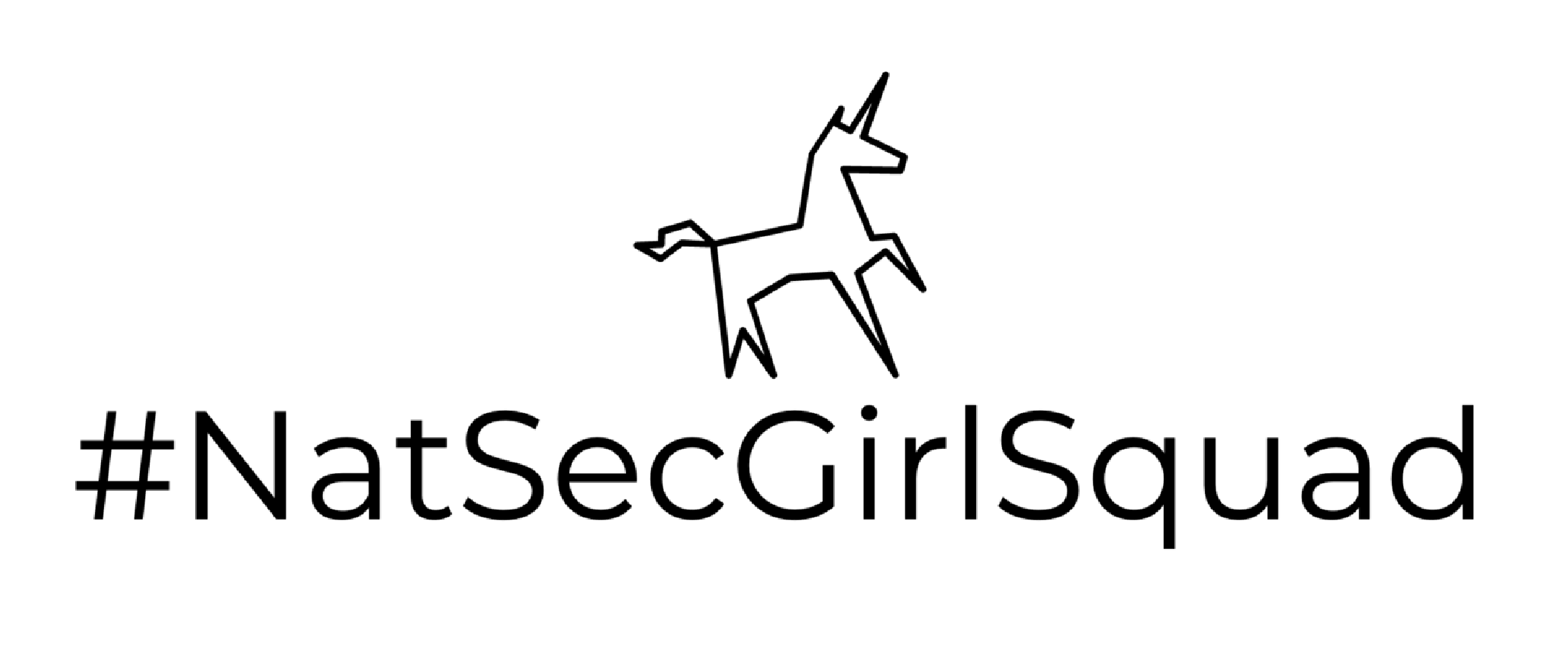CNA's Commitment to Diversity & Inclusion

CNA is committed to building and sustaining a diverse workforce and an inclusive environment.
Employees with different points of view, frames of reference and life experiences bring an energy and unique advantage that is essential to delivering on our mission.
At CNA, we believe diversity and inclusion reflects the world in which we live.
It creates a dynamic work environment that fosters trust, innovation and excellence, while providing an atmosphere where every employee feels respected, motivated and empowered to perform at a peak level.
Message from the CEO
Our Strategy and Goals
CNA has developed a concrete set of goals to guide our work and hold ourselves accountable:
- Workforce Diversity: Build and develop a diverse, high‑performing workforce by recruiting from a diverse, qualified group of potential applicants representative of all segments of the United States.
- Workplace Inclusion: Create a dynamic and inclusive work environment that fosters trust, innovation and excellence, while providing an atmosphere where every employee feels respected, motivated and empowered to perform at a peak level.
- Leadership: Equip leaders with the ability to build and sustain a diverse and inclusive workplace while creating a dynamic environment that fosters trust, innovation and excellence.
To measure our progress and achieve our goals, we have created strategies and specific actions, led and facilitated by employees at all levels and from all backgrounds.

Our Current Initiatives:
Three Pillars of Diversity and Inclusion
CNA's Diversity and Inclusion (D&I) Working Groups are an integral part of the overall D&I strategy. There are three cross-functional, employee-led working groups called "pillars."
- The Environment at CNA working group ensures CNA's environment is conducive to retaining a diverse workforce. It determines today's D&I environment baseline, identifies key issues and establishes an implementation plan to address them. Activities include lunch and learn sessions, training and an annual D&I event.
- The Hiring Pipeline working group supports CNA’s effort to develop a diverse workforce. The group explores and develops options for increasing the diversity of CNA's candidate pipeline in gender, race, academic qualifications and other demographics. The Hiring Pipeline working group also partners with Human Resources to oversee the Campus Engagement Initiative.
- The Speaker Series working group introduces and engages CNA staff with a variety of perspectives on diversity and inclusion. The Speaker Series hopes to build a conversation around the D&I key issues found at baseline and share research on the impact of D&I in the workplace.
Employee Resource Groups
Employee Resource Groups (ERGs) are employee-led groups formed around common interests and bonds or similar backgrounds. They allow members to advocate for better, more inclusive workplace and business practices. All of CNA's ERGs are voluntary and open to any employee.
Current ERGs include:
- Pride @ CNA: Offers a safe space for LGBTQ+ employees and allies to discuss concerns and celebrate pride. Contact pride_leads@cna.org with any questions.
- SupportHers: Sponsors meetings and events aimed at addressing the challenges women face in the workplace.
- D&I Coffee Table: Holds monthly get-togethers to promote education and discuss D&I content we have been reading, listening to, or watching.
- Working Parents: Identifies, recommends and helps implement actions CNA can take to assist employees with school-age or younger children.
- Young Professionals: Creates a space for new, young professionals to meet one another, find mentors within CNA, and learn how to be successful in the work environment.
Inclusive Language
At CNA, we are committed to using language that avoids bias and promotes inclusivity. To support this goal, we maintain an internal style guide based on APA Style for avoiding bias when discussing historically marginalized people and groups. These seven guidelines from our style guide help ensure our written products reflect our commitment to inclusive language.
Recruiting Partners
CNA Recruits at
- Caltech
- Carnegie Mellon University
- Catholic University of America
- Cornell University
- Duke University
- Florida A&M *
- Florida International University †
- George Mason University
- Georgia Tech
- Georgetown University
- George Washington University
- Harvard University
- Howard University *
- Johns Hopkins University
- Marymount University
- Massachusetts Institute of Technology
- Morehouse College *
- Morgan State *
- Norfolk State University *
- North Carolina A&T *
- North Carolina State University
- Pennsylvania State University
- Princeton University
- Purdue University
- Stanford University
- Texas A&M University
- Tufts University
- UCLA
- University of California, Berkeley
- University of Florida
- University of Illinois at Urbana-Champaign
- University of Maryland
- University of Miami
- University of Michigan
- University of North Carolina at Chapel Hill
- University of Pennsylvania
- University of Texas
- University of Texas El Paso †
- University of Virginia
- University of Wisconsin
- Virginia Tech
† Hispanic Serving Instituions
Diversity & Inclusion Partners













If you have any questions about CNA’s D&I efforts, please reach out to Tomi Fadeyi-Jones, fjonest@cna.org.


